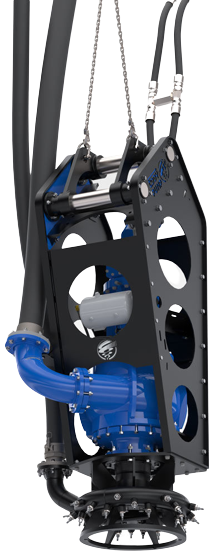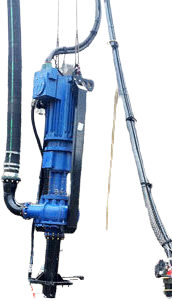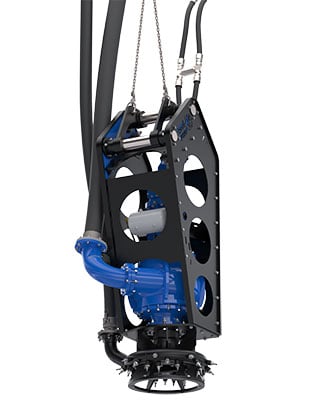Cable Deployed with Water Jetting or Barge Mounted Dredge Pumps
Cable Hanging Dredge Pumps with Water Jetting Ring can be Crane or Excavator Deployed.
Cable Or Boom Deployed Dredge Pump
The video shows an attached EDDY Dredge Pump unloading a barge with a boom deployment. This unit can also be hung from a cable or from an A-frame on floating barge. Call about your project and we can work to match your setup to our dredge pump.
This unit can be Cable or Boom Deployed.
Cable Deployed EDDY Pump with Water Jetting Agitator
Overview of this Barge Crane or Excavator mountable unit.
EDDY Pump’s submersible electric and hydraulic driven dredge pump, with water jetting ring agitator option, is a market leader in high solids pumping. Unlike other dredge pumps, the EDDY Pump design does not have an impeller, but instead a heavy duty geometrically designed rotor that creates a synchronized eddy current similar to a tornado.
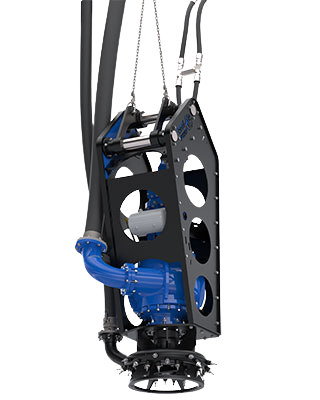
The EDDY Pump Submersible dredge pump with water jetting ring can be attached by cable and suspended from a crane, excavator, floating barge with a-frame or other devices for optimal solids pumping. The high chrome EDDY Pump will outperform any pump on the market while not clogging like conventional pumps or having downtime associated with maintaining critical tolerances.
This cable deployed dredge pump setup can be fitted with any of our 4-inch through 12-inch pumps. Production measures at 100-450 cubic yards per hour of material, at distances over 2000-ft.
The water jetting ring can be configured in ways to break up the most consolidated material while feeding the EDDYPump.
| Hydraulic Specs | PDF | PDF |
|---|---|---|
| 4-inch JPH-4000 | ENG | ESP |
| 6-inch JPH-6000 | ENG | ESP |
| 8-inch JPH-8000 | ENG | ESP |
| 10-inch JPH-10000 | ENG | ESP |
| 12-inch JPH-12000 | ENG | ESP |
Jetting Ring Specs
- 28 Jets
- Adjustable spray angle
- Adjust GPM to match application needs
Deploy Via Cable with
- Crane
- A-Frame Barge
- Excavator
Typical Applications:
- Barge Unloading
- Deep Water Dredging
- Mining
- Sand & Agg
- Oil & Gas
- Fly Ash & Coal Ash
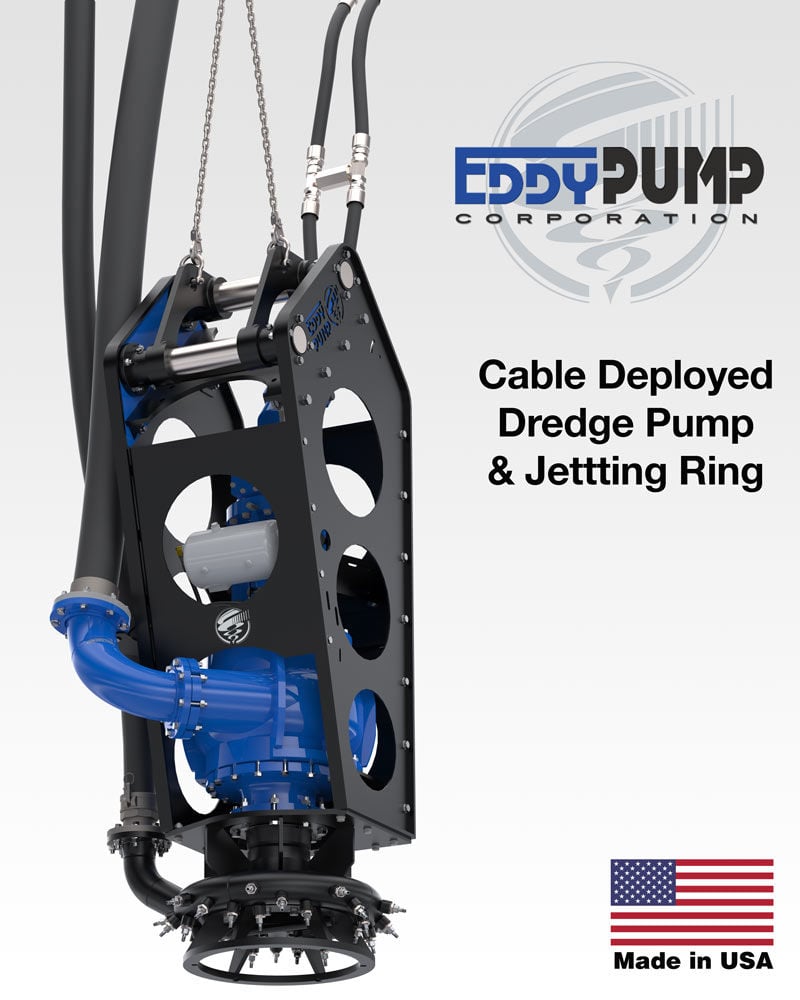
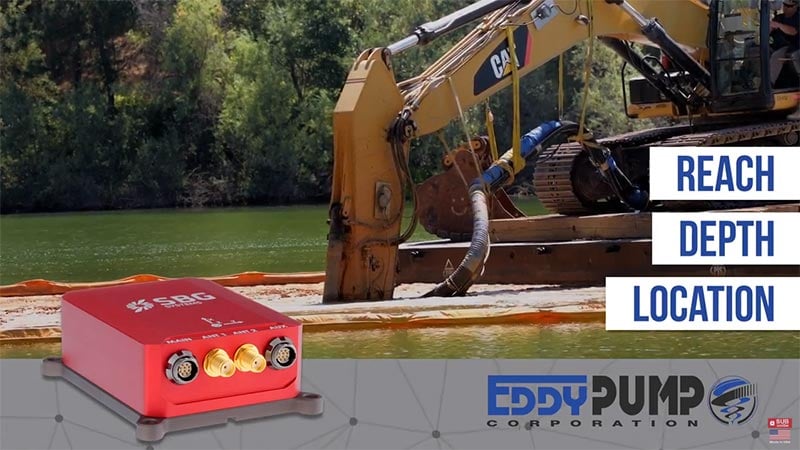
Dredge With Precision
EDDY pump offers an effective solution to track precisely where you are dredging at all times. Take out the guesswork and use detailed real-time information to your advantage.
- View Reach, Depth, and Precise GPS Location in Real-time
- Optimizes Production
- Dredge Only Target Material
- Prevents Over-dredging
- Increased Project Speed
- Reduces Equipment Maintenance
How EDDY Pump Moves More Solids With Less Water
View more pumping videos here
Talk to Engineering or Sales
Call 619-404-1916
Frequently Asked Questions
What is a cable-mounted dredge pump?
A cable-mounted dredge pump is a specialized piece of equipment used for dredging applications, particularly in areas where traditional dredging methods are impractical or ineffective. It consists of a powerful pump attached to a cable system, allowing it to be easily deployed and maneuvered in various water bodies.
How does a cable-mounted dredge pump work?
The cable-mounted dredge pump operates by using its powerful suction capabilities to remove sediment, sludge, or other materials from the bottom of water bodies. The pump is lowered into the water using the cable system and positioned over the target area. Once in position, the pump creates a vacuum, sucking up the material, which is then pumped to the desired location through a pipeline.
What are the advantages of using a cable-mounted dredge pump?
Versatility: Cable-mounted dredge pumps can be deployed in various water bodies, including lakes, rivers, ponds, and industrial lagoons.
Efficiency: These pumps are highly efficient in removing sediment, sludge, and other materials, thereby improving water quality and restoring the natural habitat.
Maneuverability: The cable system allows for precise positioning of the dredge pump, making it suitable for various dredging applications, including confined spaces and hard-to-reach areas.
Cost-effectiveness: Compared to traditional dredging methods, cable-mounted dredge pumps offer a cost-effective solution with lower operational and maintenance expenses.
What types of materials can a cable-mounted dredge pump handle?
Cable-mounted dredge pumps are capable of handling a wide range of materials, including sand, silt, clay, gravel, rocks, and organic sediments. They are commonly used in dredging projects for maintaining waterways, reclaiming land, and extracting valuable resources such as minerals and aggregates.
What sizes and capacities are available for cable-mounted dredge pumps?
Cable-mounted dredge pumps are available in various sizes and capacities to suit different dredging requirements. The size and capacity of the pump depend on factors such as the type of material being dredged, the depth of the water body, and the desired dredging rate. EDDY Pump offers a range of cable-mounted dredge pumps with customizable options to meet specific project needs.
How do I choose the right cable-mounted dredge pump for my project?
Choosing the right cable-mounted dredge pump involves considering factors such as the type and volume of material to be dredged, the depth and size of the water body, the distance to the disposal site, and any environmental or regulatory requirements. Our team of experts at EDDY Pump can provide personalized recommendations based on your project specifications and budget constraints.
What maintenance is required for a cable-mounted dredge pump?
Regular maintenance is essential to ensure optimal performance and longevity of a cable-mounted dredge pump. This may include inspecting and cleaning the pump components, checking the cable system for wear and tear, lubricating moving parts, and monitoring fluid levels. EDDY Pump provides comprehensive maintenance guidelines and support services to help you keep your dredge pump in top condition.
Can a cable-mounted dredge pump be used in environmentally sensitive areas?
Yes, cable-mounted dredge pumps are suitable for use in environmentally sensitive areas, thanks to their efficient and low-impact dredging capabilities. These pumps minimize disturbance to aquatic ecosystems and can be equipped with environmentally friendly features such as silt curtains and sediment containment systems to further mitigate any potential environmental impacts.
Is training available for operating a cable-mounted dredge pump?
EDDY Pump offers training programs and resources for operators to ensure safe and efficient operation of cable-mounted dredge pumps. Our training sessions cover topics such as equipment operation, safety procedures, maintenance practices, and environmental best practices. Additionally, our team is available to provide ongoing support and assistance as needed.
How can I purchase or rent a cable-mounted dredge pump from EDDY Pump?
To purchase or rent a cable-mounted dredge pump from EDDY Pump, simply contact our sales team or fill out the inquiry form on our website. Our experts will work with you to understand your project requirements and provide a customized solution tailored to your needs. We offer flexible purchasing and rental options to accommodate various budget and timeline constraints.
What is the purpose of a dredge pump?
A dredge pump is specifically designed to remove sediment, debris, and other unwanted materials from bodies of water, such as rivers, lakes, and ponds. It plays a crucial role in dredging operations by efficiently transferring the dredged material from the excavation site to the designated disposal area.
What is dredging and pumping?
Dredging is the process of excavating and removing sediments, silt, sand, and other materials from the bottom of water bodies to maintain or improve navigability, restore ecosystems, and facilitate construction projects. Pumping is a vital aspect of dredging, involving the use of specialized pumps to transport the dredged material through pipelines to its final destination.
What machine is used for dredging?
Various machines are used for dredging, depending on the specific requirements of the project. Cable-mounted dredge pumps, such as those offered by Eddy Pump, are commonly used for their versatility, efficiency, and ability to handle a wide range of materials and operating conditions.
What is the depth of dredging?
The depth of dredging refers to the maximum depth at which sediments and other materials can be effectively excavated and removed from the bottom of a water body. This depth can vary depending on factors such as the type of dredging equipment used, sediment characteristics, and project requirements.
What is pump depth?
Pump depth, also known as suction depth, is the maximum depth at which a dredge pump can effectively draw in water and sediments for pumping. It is an important consideration in dredging operations, as it determines the pump’s ability to remove material from the excavation site efficiently.
How do you calculate dredging volume?
Dredging volume is typically calculated by multiplying the cross-sectional area of the dredge cut (the area of the excavation site) by the distance the material is to be moved. This calculation helps estimate the total volume of material that needs to be dredged and transported, aiding in project planning and resource allocation.
What is the capacity of a dredge?
The capacity of a dredge refers to the amount of material it can excavate and transport within a given timeframe, usually expressed in terms of cubic meters or cubic yards per hour. This capacity depends on various factors, including the size and power of the dredging equipment, the type of material being dredged, and the operating conditions of the project site.

